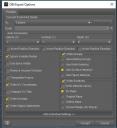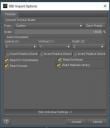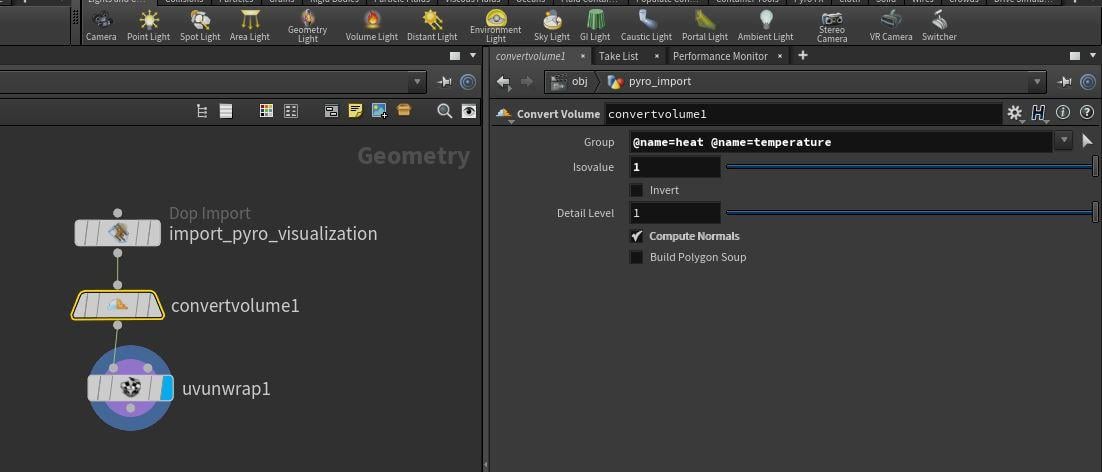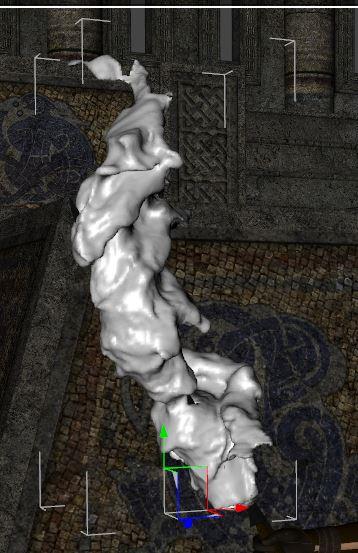DAZ Studio and Houdini - Go procedural!
The purpose of this thread is to serve as a resource for 1) using DAZ assets in Houdini and 2) using Houdini to create/modify assets for use in DAZ Studio.
Scale
One of the more important things to be aware of when transferring geometry between DAZ Studio and Houdini is the different scales they use. This is critical for when using geometry in a physics simulation since default gravity is -9.8 meters per second squared an object that is 100 times bigger than it should be won't behave correctly.
DAZ - 1 unit = 1 centimeter
Houdini - 1 unit = 1 meter
Exporting Assets from DAZ Studio + Importing into Houdini
.obj
These are the settings I use for exporting objs for use in Houdini. Houdini supports UDIM so there is no need to collapse UV tiles. Houdini does not read mtl files so there is no reason to generate them. With a scale of 1% the object will be the correct size when imported into Houdini. To import an obj in Houdini use a File node inside a Geometry object.

.dae COLLADA
In addition to geometry, cameras and lights can also be exported with this format. I have not had success in getting rigging or animation working with COLLADA so this merits further investigation. To import into Houdini use File --> Import --> Collada... Use a custom scale of 100.
.fbx
In addition to geometry, cameras and lights can also be exported with this format. I have had very little success in getting FBX to work with Houdini so this merits further investigation. To import into Houdini use File --> Import --> Filmbox FBX... Use Compatibility Mode FBX Standard. Imported objects will need to manually be scaled down by a factor of .01.
.mdd (requires https://www.daz3d.com/animate2)
Set scale to 1% when exporting. To import into Houdini, create an MDD node and link the output of the File node that loads the obj to the MDD node's input. Note that Houdini does not have a frame 0, it starts on frame 1, so any animation of frame 0 will not load.
.abc (requires https://www.daz3d.com/alembic-exporter-for-daz-studio)
When exporting, if the Preserve SubDivision Surfaces option is selected the geometry will be exported as base resolution with a flag indicating subdivision. To import into Houdini use File --> Import --> Alembic Scene... Change Start Frame to 0. Once imported create a Null node, change it's Uniform Scale to .01, and link the output of the Null node to the input of the imported Alembic node. This will scale the geometry to the correct size. If you exported with the Subdivision checkbox checked, Houdini will add a render time subdivision flag to all imported geometry. The Houdini render time subdivision algorithm is different from the on DAZ Studio uses so if you render with Mantra the geometry make look "wrong". To turn this off, dive into the Alembic, dive into the Alembic Transform, select the Geometry node, click on Render, click on Geometry, clear Render Polygons as Subdivison (Mantra). This is only necessary if you are going to use the Mantra render engine. There is currently an issue where the DAZ Studio Alembic Exporter creates geometry with reversed normals. This will cause errors in simulation and slow or incorrect rendering of surfaces. To fix this, dive into the Alembic, dive into the Alembic Transform, dive into the Geometry node, select the Alembic node, change Load As from Alembic Delayed Load Primitives to Unpack Alembic Delayed Load Primitives. Create a Reverse node, connect the output of the Alembic node to the input of the Reverse node, and set the blue display flag on the Reverse node.
Exporting Assets from Houdini + Importing into DAZ Studio
A note on exporting from Houdini is that DAZ Studio only understands polygonal geometry so any objects you export must first be converted into polygons if they are not already. Doing this for Houdini volumes (fire, smoke, water) will be covered in a future post.
.obj
There are multiple ways to export an .obj. The easiest is to right click on the geometry node you wish to export, right click, Save --> Geometry..., enter a path and a file name that ends in obj. To import in DAZ Studio use File --> Import... Use the following setting to scale the geometry. Note that Houdini does not automatically create UVs for geometry, if you want UVs you will need to apply UV nodes in Houdini and export those or create the UVs in a tool of your choice.

.fbx (Requires Houdini Indie or higher license)
Use File --> Export --> Filmbox FBX... To import in DAZ Studio use File --> Import... I have had zero success in importing an FBX into DAZ Studio, even a simple cube with no animation will cause DAZ Studio to crash.
Information is based on DAZ Studio 4.9 and Houdini 16. Corrections and suggestions to this information are welcome. Future posts will cover more advanced topics.






Comments
Thanks for this info
I am considering dumping maxon all together and moving to Houdini.
It is good to see it supports an MDD work flow.
looking forward to more.
I'll take C4D off your hands when you do, LOL
Thanks. I really like the node system in Houdini. I am learning it right now.
I can't begin to express my love for Houdini. It was the only program able to solve my ship destruction problem and you can get an apprentice version for free.
Houdini PyroFX to geometry + DAZ Studio Iray setup
This is an example workflow for using Houdini's PyroFX (fire/smoke simulation) in DAZ Studio with Iray. Because DAZ Studio and Iray do not support VDBs (a format for storing voxels, used for storing volumes such as fire and smoke) or volumes with varying density, the fire and smoke will never look as good in Iray as it does in a render engine that supports these.
As there are plenty of free tutorials online for using Houdini made by professionals I will not go into details of how to use it, instead focusing on the parts of the workflow relevant to DAZ Studio users.
1. Export geometry you want your flame to interact with from DAZ studio using one of the methods from the previous post.


2. Import the geometry into Houdini.
3. Create a PyroFX fuel source. In this example scene I created a copy of the sword's blade, selected and deleted geometry from the ends, and then translated it slightly in front of the original blade, and used this as a the fuel source.
4. Set collision object(s). I used the imported blade and a sphere I positioned at the hilt (to prevent the fire from spreading to the handle) as collision sources.
5. Run the pyro simulation and tweak as desired. I used the Smokeless Flame shelf tool. When you get the fire looking like you want select a frame for export.
6. Dive into the pyro_import node that the pyro simulation autogenerated.
7. Create a Convert Volume node and connect the output of the Dop Import node labeled import_pyro_visualization to the input of the Convert Volume node.
8. On the Convert Volume node, set the Isovalue to 1, check Compute Normals, and set group to the value @name=heat @name=temperature
9. Create a UV Unwrap node and connect the output of the Convert Volume node to the input of the UV Unwrap node.
10. Right click on the UV Unwrap node, Save --> Geometry..., pick a folder and file name and make sure the file name ends in .obj (ex. flame.obj).
11. Import the obj per the previous post into DAZ Studio.
12. Apply Iray Base shader to the imported geometry, set the emission surface properties, and use a fire texture as the emission. I used one of Jepe's fire surfaces for the images and set a tile factor of 50.
13. Optional, set bloom filter to taste in Iray render settings.
14. Render.
Can one export objects created in Houdini Apprentice version as .OBJs?
Never mind, just found the answer on https://www.sidefx.com/filmtv/compare/
Thank you for this tutorial. I'm currently learning C4D which I love for other things but dissapointed that to achieve nice particle effects you'll need expensive plug ins.
I'm still unfamiliar with Houdini. Would you recommend this program if someone wanted to create fire/ water / etc?
Stock C4D is useless if you want to flood or burn stuff.
I have many external plugins to enhance My older version of C4D
(Realflow for fluids etc.) But like many other long time users of C4D, I have grown tired
of depending on external add-ons to give C4D the functionality
present in other pro applications like Maya and Houdini.
as soon as I am able to buy the hardware upgrades I want,
it will be bye bye Maxon for me.
I had a hunch that was the case.. Although for me it will be tough to give up Mograph
I'm all in favor for a Houdini thread! Seeing some of the flame effects you can get done in this program sounds like a great way to breathe new life in Daz
Whoa ! Dude, I nearly hit the floor when I seen the price of Houdini .Holy Macaroni. Its cool they have a free learning version like autodesk.. but it leaves water marks also so that leaves you having to buy the indie version if you use it to create something in a student project that you want to show in a indie film festival under a $1k.. One thing that I did notice is the pay for as you go which is more or less Houdini cloud. still expensive though. must be a heck of a software. to cost you over $6000 a year to use it not including HOUDINI ENGINE render engine rental cost at $499 annually .. wicked :D
Indeed mograph has no equal however ,in my mind, it does not compensate for the areas where C4D
continues to fall behind similary ( even lower) priced program
.
It's Great if you want to do the opening title sequence 3D graphics
for the Superbowl but what about full animated movies with multiple Characters??
They just released version R19
for $3,700 USD for the studio full package
Yet still no ability to retarget external mocap,BVH to native C4D rigs
No ability to auto generate lipsinc from audio files in C4D
No ragdoll physics with C4D native rigs
no ability to actually have a C4D rig move with Dynamic clothing
Only the draping a tablcloths,bedsheets and curtains.
I am still running version 11.5( yeah.. really old)
but instead of Dumping more money down the maxon upgrade sink hole
over that last 8 or so years I have ( at great personal cost), invested in external
solutions to give my "old" version abilities that the logo spinners at Maxon
continue to ignore even to this Day.
For Fluid Dynamics I have the realflow with the C4D bridge plugin.
For the Character animated stuff I have the combination of Iclone Pro ,Daz studio& Endporphin
With the aniMate2 MDD export to send my animated Daz meshes to C4D for rendering
for smoke.particle and fire effects I have older versions of Autodesk combustion
and of course Adobe after effects CS.
This is working for me now but I do long for a more unified pro application solution
and if things go my way as I hope,
That Solution will likely be some version of Houdini.
Indeed! Lets keep this thread going
Just a heads up, Udemi is offering a $10 course on Houdini for beginners.
https://www.udemy.com/houdini-create-full-cg-chocolate-commercial-in-houdini/
I've used Udemi to learn other applications before and they're great.
Houdine indie is fine if your Annual grose revenue Isn't over $100,000 if your revenue is that high I think you will be fine splashing out a little on the bigger licenses, and also that any third parties you create work for collectivly do not gross more than $100,000 i.e. if you earn 50k they can't earn more than 50k
Houdini FLIP Fluid to geometry + DAZ Studio Iray setup
I have seen a few requests about creating dynamic water that interacts with DAZ objects in the last few weeks so I have put together the steps for an example how to do this with Houdini.
1. Export geometry you want your water to interact with from DAZ studio using one of the methods from the previous post. In this example I am using a Genesis 3 Female as the collision geometry.
2. Import the geometry into Houdini.
3. Select the imported geometry and from the Collisions shelf click Static Object.
4. Create a primitive that is going to act as the splash of water. In this example I used a sphere which I added a Transform node to so I could scale and position it.
5. Select the geometry you are using as the water source and click Flip Fluid from Object from the Particle Fluids shelf.
6. Tweak the simulation settings. In this example I made these tweaks:
a. In AutoDopNetwork in flipfluidobject1 I set Initialize Velocity to 0, 0, -2 so the water is splashing into the character.
b. In the flipfluidobject1 I set Friction to .52 so the water will not instantly slide off the character (the default of 0 is no friction)
c. In the flipfluidobject1 I lowered the Particle Separation. This is the value that controls the resolution of the simulation. The lower the value the more simulated fluid particles, the more detailed the geometry will be, the more RAM and CPU time needed to calculate the simulation.
d. In AutoDopNetwork in the Static Object (the node name will be the name of the imported geometry) I set Laser Scan.
e. In AutoDopNetwork in the flipsolver1 I turned Detect Droplets
7. Run the simulation and when you have a frame you like go into the fluidinterior node, right click on the object_merge1 node, Save --> Geometry..., pick a folder and file name and make sure the file name ends in .obj (ex. water.obj)
8. Import the obj per the previous post into DAZ Studio.
9. Apply an Iray water shader to the imported object.
10. Render.
For more information on how to control the look of the simulation, search for Houdini FLIP. There are many tutorials on Youtube and Vimeo.
It is great to see Daz artists integrating Houdini into their workflow. Houdini is the primary tool used for procedural VFX work. If you have seen a major Blockbuster, you have seen it use. We teach it at my University. Below are a few links that show its capabilities as well as some free tutorials from our department.
A. COMPANY REEL
2017 Houdini Customer Reel:
https://vimeo.com/226906993
2016 Houdini Customer Reel:
B. A FEW HOUDINI ARTISTS
Carlos Parmentier (Houdini Artist that focuses on Fluids):
https://vimeo.com/user2149850
Apoorva Shah:
https://vimeo.com/166857562
Ryan Bowden:
https://vimeo.com/122065928
C. INTRO INSTRUCTIONAL HOUDINI VIDEOS
https://vimeopro.com/cotpurdue/intro-to-houdini/page/1
https://vimeopro.com/cotpurdue/intro-to-houdini/page/2
Carlos
I'm just starting to learn Houdini - so would love to see a thread that addresses integration between DAZ content and Houdini (Apprentice to learn and indie after that)
What kind of integration information are you looking for? Currently the only way to get geometry between DAZ and Houdini is through export/import of file types that are mutually supported.
I'd like to know if there's a consistent path by which you can bring props and / or figures, with or without textures, animations, and morphs from DAZ Studio or Carrara into Houdini's indie Version.
I have Fenric's MDD Exporter but I didn't have any luck with that, nor did anything show up in the viewport of houdini Apprentice when I tried to import a .obj file (showed error in the network area)
Almost purchased the Alembic Exporter during the annual sale but didn't end up doing so, because I didn't realize that format might help. Any idea if that serves as a useful bridge? Would also consider paths through Unity or Blender or iClone / 3DExchange if those are simple and reliable, though would prefer to minimize extra programs to simplify the pipeline and minimize need for learning extra software.
Thanks this is great info for imports/exports I just upgraded to 17 indie for 2Yrs this is a great help !
What was the error you got when you imported the obj?
Morphs can only be exported to Houdini through FBX which I haven't had much testing with so I can't help with that. I know the FBX in H17 and 16.5 works better than when I originally posted with H16.
As far as materials go, FBX will create a very basic material setup for Mantra but the settings are pretty terrible so any materials you will want to recreate. It would be possible to write a script to export material settings and import them with some conversion logic.
@Midnight_stories and @RobotHeadArt - sorry for the delayed reply. I thought I was set up to receive notifications when someone replied to threads I was following.
In terms of error messages, I'll copy those down and post back next time it happens.
In terms of exporting a .obj file from DAZ Studio and opening in Houdini, I just tried the method outlined above with the same settings. I then created a new Geometry node in Houdinini, went inside of that node, hit TAB>Import>File and then navigated to the desired .obj file - but nothing shows up in my viewport. Have tried with different objects without success.
Still just finding my way around Houdini - so entirely possible I'm leaving out a simple step. I do have the blue visibility flag on for my noe - and the name of the file is recognized by houdini - but no mesh /geometry shows up. I get a red triangle with exclamation mark warning if I'm in frame 0, but that goes away if I advance to frame 1 - but still don't see anything in viewport.
Attaching a couple of images from Houdinin interface that pop up if I middle mouse over the object I'm trying to import ("BRCH_Steps_FH") in the Network view or Tree view
Can't get .obj to show up in houdini from DAZ Studio or Carrara.
If I export an MDD file from DAZ Studio, that does show up in houdini as vertices (not seeing surfaces or shading)
Exporting MDD from Carrara, I don't see anything show up in Houdini.
Did some searching on the web, and after converting my .obj files to .bgeo files, i can now import those into Houdini via file import.
(convert in Houdini by going to Windows>Shell then when Command window opens, navigate to the directory where ou have your obj files and type "gwavefront currentFileName.obj currentFileName.bgeo" - may take a few seconds for process to complete - can then import that bgeo file into houdini)
The object/bgeo shows up as vertices and polygons - no textures at this point, but at least it's a start and will keep plugging away.
That's a very strange error. I wonder if it doesn't like the path you provided. You could submit it as a bug to SideFX. You shouldn't have to convert an .obj to .bgeo to open it.
MDD is actually points, you have to import the obj and use that as input into the MDD since that is what moves the verticies.
You won't see textures in the viewport with any import options formats except for FBX and even then FBX is dicey as the default shaders are really basic. The best you get is groups which you can use with the Material SOP which lets you assign materials (think DAZ shaders) to the groups. You can see the imported groups in the Geometry Spreadsheet view or hitting the i for Node info on the file node. Here I imported G3F and you can see the surfaces as groups (Face, arms, torso, etc.).
Was wondering if PATH was messed up.
$HIP doesn't bring me to my default Houdini Project directory - but not sure if it's supposed to or how to change those paths.
If I could consistently get DAZ figures into Houdini and have a reasonably quick way to reapply the textures, I think I'd get the Indie Version (instead of apprentice) and try to start learning the system.
I had used the Geometry Spreadsheet and did see some references, so I do think the info was brought in - though my efforts to follow a tutorial bogged down and I wasn't able to successfully apply them back to the figure.
Is there a way to reduce shading domains so you only have to reattach a few textures instead of many?
Thanks for any suggestions.
RobotHeadArt, how are things going, did you manage overcome the problems mentioned when doing the OP? I am also using Houdini with Daz Characters, but I am using VRAY to render inside Houdini - they have a nightly beta which you can try out for free https://nightlies.chaosgroup.com/main#/vray4houdini/nightly - it's very unstable, but giving me much better results than iRay.
Anyway, I just wanted to ressurect the thread - maybe we should do a Discord or Skype group, just people using Daz with Houdini so we can exchange information, workflows, settings etc. It's safe to say that Houdini is the hardest, but the best 3D software and gives you so much more freedom than Maya, Blender or iClone.
Just very happy to see fellow Dazzers playing in the big league :)
George
Have been busy with other things, but hoping to go through a bunch of Houdini tutorials in upcoming weeks - and would love to have an active thread in which we can share information about integrating DAZ content with that program.
I'm subscribing to this thread it look interesting!
I've been busy with some good life changes so I haven't had time to get back to my Houdini projects. I'm hoping I'll have more time later this summer. As far as updates, FBX in H16.5 and DAZ Studio 4.10 seems to have resolved some issues, as I was able to get an FBX from DAZ to Houdini with some form of rigging. I don't know Houdini's rigging system well enough to tell if it's usable or it would be better off building the rig from scratch in Houdini. The issue with DAZ Studio's Alembic exporter flipping the normals seems to have been fixed in the DAZ Studio 4.11 beta.
Houdini's game development toolset has had some awesome improvements and new tools that I think DAZ PA's would find interesting for creating DAZ studio content. Some cool things added recently are:
Any and all are welcome to add any new information or share their workflows in this thread! I hope to hear how others are using Houdini with DAZ Studio.